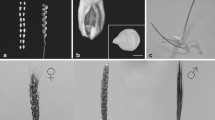Summary
Sixty-three plants producing 2n pollen were identified among 65 introductions of 11 2x, 2EBN wild species. They were found in 27 of the 65 introductions representing ten of 11 species. The gene frequencies for the allele controlling 2n pollen formation ranged from 0.19 to 0.65. Seventyeight haploid x wild species hybrid families were produced using the previously identified 2n pollen plants as male parents. One hundred and thirty-two plants that produced 2n pollen were identified among the haploid x wild species hybrids at one location and 44 at another. The high number of haploid x wild species hybrids that produced 2n pollen and the large number of hybrids with acceptable pollen stainability demonstrate the potential of the hybrids in 4x × 2x germplasm transfer. Potato breeders can unleash the genetic diversity present in the 2x, 2EBN wild species by screening them for 2n pollen and crossing the 2n pollen producing plants to haploids.
Similar content being viewed by others
References
Camadro, E. L. & S. J. Peloquin, 1980. Occurrence and frequency of 2n pollen in three diploid Solanums from Northwest Argentina.Theoretical and Applied Genetics 56: 11–15.
Den Nijs, T. P. M. & S. J. Peloquin, 1977. 2n gametes in potato species and their function in sexual polyploidization.Euphytica 26: 585–600.
Hanneman, R. E., Jr. & J. B. Bamberg, 1986. Inventory of tuber-bearingSolanum species. Wisconsin Agricultural Experiment Station Bulletin No. 533.
Hawkes, J. G., 1945. The indigenous American potatoes and their value in plant breeding.Empirical Journal of Experimental Agriculture 13: 11–40.
Hawkes, J. G., 1958. Significance of wild species and primitive forms for potato breeding.Euphytica 7: 257–270.
Hermundstad, S. A. & S. J. Peloquin, 1985a. Male fertility and 2n pollen production in haploidwild species hybrids.American Potato Journal 62: 479–487.
Hermundstad, S. A. & S. J. Peloquin, 1985b. Germplasm enhancement with potato haploids.Journal of Heredity 76: 463–467.
Hermundstad, S. & S. J. Peloquin, 1986. Tuber yield and tuber traits of haploid-wild species F1 hybrids.Potato Research 29: 289–297.
Hougas, R. W. & S. J. Peloquin, 1962. Exploitation ofSolanum germplasm, p. 21–24. In: D. S. Correll (Ed.), The potato and its wild relatives section Tuberarium of the GenusSolanum. Texas Research Foundation, Renner, Texas.
Huaman, Z. & R. W. Ross, 1985. Updated listing of potato species names, abbreviations and taxonomic status.American Potato Journal 62: 629–641.
Iwanaga, M. & S. J. Peloquin, 1982. Origin and evolution of cultivated tetraploid potatoes via 2n gametes.Theoretical and Applied Genetics 61: 161–169.
Johnston, S. A., T. P. M. den Nijs, S. J. Peloquin & R. E. Hanneman, Jr., 1980. The significance of genic balance to endosperm development in interspecific crosses.Theoretical and Applied Genetics 57: 5–9.
Kotch, G. P. & S. J. Peloquin, 1987. A new source of haploid germplasm for genetic and breeding research.American Potato Journal 64: 137–141.
Leue, E. F., 1983. The use of haploids, 2n gametes and the topiary mutant in the adaptation of wildSolanum germplasm and its incorporation into Tuberosum. Ph.D. thesis, University of Wisconsin-Madison, 189 pp.
Marks, G. E., 1954. An acetocarmine glycerol jelly for use in pollen fertility counts.Stain Technology 29: 277.
Mather, K., 1938. The measurement of linkage in heredity. John Wiley and Sons, Inc., New York.
Mok, D. W. S. & S. J. Peloquin, 1975. The inheritance of three mechanisms of diplandroid (2n pollen) formation in diploid potatoes.Heredity 35: 295–302.
Quinn, A. A., D. W. S. Mok & S. J. Peloquin, 1974. Distribution and significance of diplandroids among the diploidSolanums.American Potato Journal 51: 16–21.
Rudorf, W., 1958. The significance of wild species for potato breeding.European Potato Journal 58: 10–20.
Author information
Authors and Affiliations
Rights and permissions
About this article
Cite this article
Yerk, G.L., Peloquin, S.J. 2n pollen in eleven 2x, 2EBN wild species and their haploid x wild species hybrids. Potato Res 31, 581–589 (1988). https://doi.org/10.1007/BF02361850
Accepted:
Issue Date:
DOI: https://doi.org/10.1007/BF02361850




